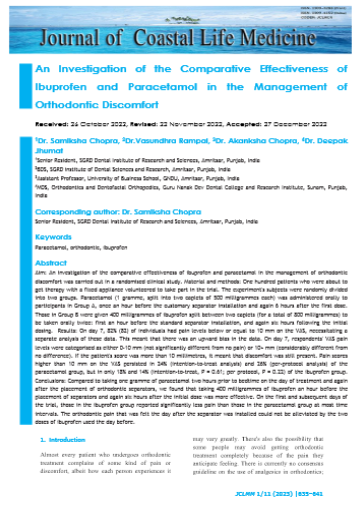An Investigation of the Comparative Effectiveness of Ibuprofen and Paracetamol in the Management of Orthodontic Discomfort
Main Article Content
Abstract
Aim: An investigation of the comparative effectiveness of ibuprofen and paracetamol in the management of orthodontic discomfort was carried out in a randomised clinical study. Material and methods: One hundred patients who were about to get therapy with a fixed appliance volunteered to take part in the trial. The experiment's subjects were randomly divided into two groups. Paracetamol (1 gramme, split into two caplets of 500 milligrammes each) was administered orally to participants in Group A, once an hour before the customary separator installation and again 6 hours after the first dose. Those in Group B were given 400 milligrammes of ibuprofen split between two caplets (for a total of 800 milligrammes) to be taken orally twice: first an hour before the standard separator installation, and again six hours following the initial dosing. Results: On day 7, 82% (82) of individuals had pain levels below or equal to 10 mm on the VAS, necessitating a separate analysis of these data. This meant that there was an upward bias in the data. On day 7, respondents' VAS pain levels were categorised as either 0-10 mm (not significantly different from no pain) or 10+ mm (considerably different from no difference). If the patient's score was more than 10 millimetres, it meant that discomfort was still present. Pain scores higher than 10 mm on the VAS persisted in 24% (intention-to-treat analysis) and 26% (per-protocol analysis) of the paracetamol group, but in only 18% and 14% (intention-to-treat, P = 0.61; per protocol, P = 0.22) of the ibuprofen group. Conclusions: Compared to taking one gramme of paracetamol two hours prior to bedtime on the day of treatment and again after the placement of orthodontic separators, we found that taking 400 milligrammes of ibuprofen an hour before the placement of separators and again six hours after the initial dose was more effective. On the first and subsequent days of the trial, those in the ibuprofen group reported significantly less pain than those in the paracetamol group at most time intervals. The orthodontic pain that was felt the day after the separator was installed could not be alleviated by the two doses of ibuprofen used the day before.
Article Details
References
Oliver RG, Knapman YM. Attitudes to orthodontic treatment. Br J Orthod 1985;12:179-88.
Ngan P, Wilson S, Shanfeld J, Amini H. The effect of ibuprofen on the level of discomfort in patients undergoing orthodontic treatment. Am J Orthod Dentofacial Orthop 1994;106:88-95.
Steen Law SL, Southard KA, Law AS, Logan HL, Jakobsen JR. An evaluation of preoperative ibuprofen for treatment of pain associated with orthodontic separator placement. Am J Orthod Dentofacial Orthop 2000;118:629-35.
Bernhardt MK, Southard KA, Batterson KD, Logan HL, Baker KA, Jakobsen JR. The effect of preemptive and/or postoperative ibuprofen therapy for orthodontic pain. Am J Orthod Dentofacial Orthop 2001;120:20-7.
Polat O, Karaman A. Pain control during fixed orthodontic appliance therapy. Angle Orthod 2005;75:210-5.
Vane JR. Inhibition of prostaglandin synthesis as a mechanism of action for aspirin-like drugs. Nat New Biol 1971;231:237-9.
Chandrasekharan NV, Dai H, Lamar Turepu Roos K, Evanson NK, Tomsik J, Elton TS, et al. COX-3, a cyclooxygenase-1 variant inhibited by acetaminophen and other analgesic/antipyretic drugs: cloning, structure, and expression. Proceedings of the National Academy of Sciences of the United States of America 2002;99: 13926-31.
Walker JB, Buring SM. NSAID impairment of orthodontic tooth movement. Ann Pharmacother 2001;35:113-5.
Kehoe MJ, Cohen SM, Zarrinnia K, Cowan A. The effect of acetaminophen, ibuprofen, and misoprostol on prostaglandin E2 synthesis and the degree and rate of orthodontic tooth movement. Angle Orthod 1996;66:339-49.
Powell CV, Kelly AM, Williams A. Determining the minimum clinically significant difference in visual analog score for chil- dren. Ann Emerg Med 2001;37:28-31.
Moher D, Schulz KF, Altman D, CONSORT Group. The CONSORT statement: revised recommendations for improving the quality of reports of parallel-group randomized trials. JAMA 2001;285:1987-91.
McAlinden RL, Ellis PE, Sandy JR. Report of an adverse incident in a randomized clinical trial. J Orthod 2005;32: 203-5.

